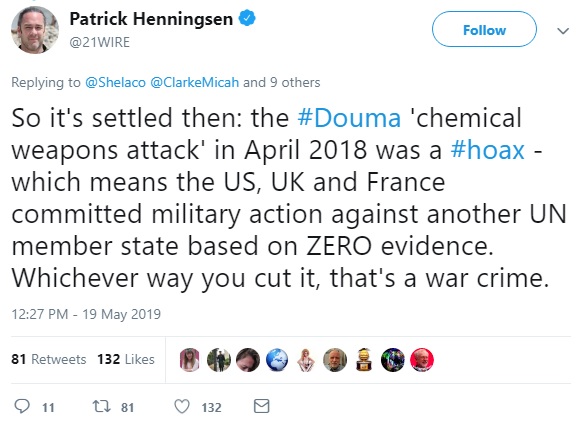New details have emerged regarding claims that investigators from the Organisation for Prohibition of Chemical Weapons (OPCW) “suppressed evidence” in their report of an alleged chemical attack in Syria.
In March, after a lengthy investigation, the OPCW’s Fact-Finding Mission (FFM) issued a report which found “reasonable grounds” for believing a toxic chemical had been used as a weapon in Douma and suggested the chemical was delivered by two gas cylinders dropped from the air.
Last week, an internal OPCW document surfaced on the internet expressing a contradictory view. Written by a OPCW employee, Ian Henderson, it claimed the cylinders were likely to have been “manually placed” in the spot where they were found, rather than being dropped from the air.
How the cylinders got there is a crucial question. If they were dropped from the air the Assad regime must have been responsible, since rebel fighters in Syria had no aircraft.
On the other hand, the idea that they were “manually placed”, as proposed in Henderson’s document, has been interpreted as support for long-standing claims by Russia and the Syrian government that there was no chemical attack in Douma and that rebels planted the cylinders in order to falsely accuse the regime.
Henderson’s document, with its “manually placed” explanation for the cylinders, was not mentioned in the official FFM report — which raises the question why not. When it was leaked and posted on the internet conspiracy theories burgeoned.

On social media, fans of the Assad regime treated the leaked document as automatic proof that the FFM’s report was wrong, and the Working Group on Syria, Propaganda and Media — which published the leaked document — presented it as evidence of a western plot to suppress the truth. The OPCW, it said, “has been hijacked at the top by France, UK and the US”.
Investigating the cylinders and the related damage was a highly technical business. It involved complex analysis, including computer modelling, and the FFM commissioned specialist studies from experts:

There were three studies by experts from three different countries, working independently. According to the OPCW all three separately reached the same conclusions and these were reflected in the FFM’s report.
Henderson, meanwhile, was working on what the leaked document describes as an “engineering assessment”. He used the same data as the FFM’s experts but reached a different conclusion.
Like the FFM, Henderson also consulted outside experts, though their role is not very clear. It appears from the leaked document that his computer modelling may have been done in-house, with the experts only providing guidance on how to do it.

Henderson handed in the final draft of his assessment on 27 February — just two days before the FFM’s report was published.
What happened next has been a cause of much speculation but an informed source has now shed some light on it.
The key point here is the FFM’s terms of reference. Its basic role was to establish facts about the alleged attack, and it was not allowed to apportion blame — that is the job of the OPCW’s newly-created Investigation and Identification Team (IIT).
Although the FFM determined that the cylinders were probably dropped from the air, the published report (in line with its mandate) omitted any mention of the obvious implication that they had been dropped by regime aircraft.
According to the informed source, when Henderson’s assessment was reviewed there were concerns that it came too close to attributing responsibility, and thus fell outside the scope of the FFM’s mandate.
Whether or not that was the right decision, there was no doubt that Henderson’s assessment did fall within the mandate of the new Investigation and Identification Team. For that reason, according to the source, he was advised to pass it to the IIT instead — and he did so (though it’s not clear when).
The brief of the IIT is to identify “the perpetrators of the use of chemical weapons” in Syria and to report on “all information potentially relevant to the origin of those chemical weapons”.
The OPCW is understood to have given assurances that the IIT will “consider” Henderson’s assessment as part of any forthcoming work on Douma.

 RSS Feed
RSS Feed
